
Original Link: https://www.anandtech.com/show/2792
Memory Scaling on Core i7 - Is DDR3-1066 Really the Best Choice?
by Gary Key on June 24, 2009 9:00 AM EST- Posted in
- Memory
And we begin, with a graph:
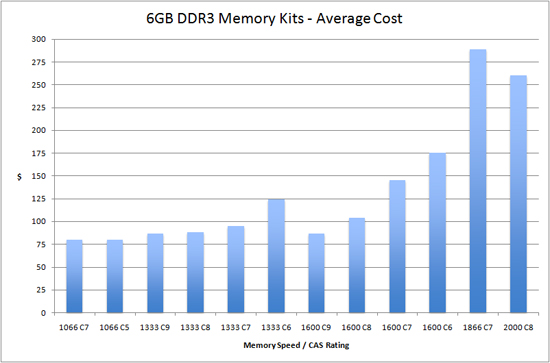
The graph above represents the cost, from Newegg.com, of 11 different 6GB DDR3 memory kits (1066 C7/C5 are the same kit). The only variables are the manufacturer and speed of the DDR3 memory included in the kit.
The least expensive DDR3-1066 6GB kit we purchased sells for $80, the most expensive 6GB kit? $289. That’s over a $200 difference; that and some pocket change is enough to pay for a sweet new video card, a nice 22” monitor, or even a iPhone 3GS.
All of that extra money is going somewhere: frequency and latency. The lowest end kit has a data rate of 1066MHz and a CAS latency of 7 cycles. The most expensive kit has a 1866MHz data rate at the same CAS latency; that’s a 75% increase in data rate.
A 10% increase in CPU speed rarely yields more than a 4 or 5% increase in performance, but what about a 75% increase in memory speed? We don’t have a single page on AnandTech to point you to that would answer that question. At least we didn’t, until today.
A Brief History of DDR3
We first met DDR3 alongside Intel’s P35 chipset. It’s performance at the time was at best equal to or usually worse than DDR2 while carrying a significant price premium. It wasn’t until the release of the Intel X48 and NVIDIA 790i chipsets that Socket 775 users could even see an advantage to using DDR3 and even then, it was primarily for benchmarking contests - hooray, because we all know how important those are.
There were some tangible advantages to DDR3 from the start, the biggest being it’s lower operating voltage. DDR2 memory required 1.8V while DDR3 could run at 1.5V, this made DDR3 particularly attractive for notebooks but on the desktop the advantage was sort of abused.
In order to take advantage of DDR3’s higher memory speed, benchmarking enthusiasts often had to use DDR3-1866/2000 kits that required voltages in the 1.8V~2.0V range to reach these clock speeds. Performance improvements in certain benchmarks were available through brute force use of voltages and ICs that allowed high memory speeds at decent latencies. In the end, improvements in actual applications were just not worth the cost or trouble of using DDR3 compared to DDR2.
Intel made no secret of its plans to move the vast majority of their processor lineups to DDR3 memory a few years ago. They truly wanted/desired that DDR3 would be the standard memory of choice by the time P45/X48 launched, but DDR3’s limited availability, middling performance, and a price premium that was truly prohibitive for the mainstream crowd, let alone the enthusiast market space made this desire impossible. As such, this left users with memory controllers not truly optimized for either memory technology that resulted in performance not significantly different from earlier Core 2 supporting S775 chipsets.
AMD recently released the AM3 platform and their AM3 based Phenom II processors support both DDR2 and DDR3 allowing users to either upgrade to AM3 boards or keep using their DDR2 based AM2+ boards, a simple if not elegant solution. With the recent release of new boards, BIOS optimizations, and near cost parity with DDR2, we now think DDR3 is a viable option for AMD users.
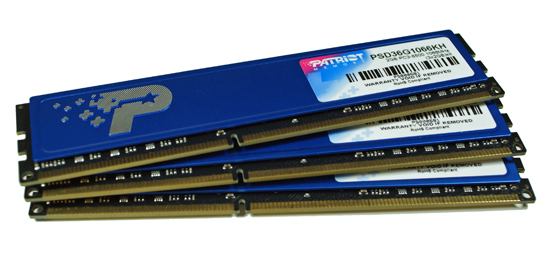
That said, DDR3 started coming into its prime last fall as the release of second and third generation DDR3 devices along with Intel’s Core i7. Core i7 and the X58 platform introduced Intel’s first on-die memory controller. Aside from other architectural improvements, Core i7 supports three DDR3 memory channels compared to the standard two channel setup, yielding some impressive bandwidth numbers.
There was one problem with this new design, a real fly in the ointment actually for the memory suppliers. Current JDEC specifications list 1.50V as the official voltage specification for DDR3 with a move to 1.35V in the near future and eventually to 1.20V. However, most of the performance oriented DDR3 modules released for the Core 2 platforms generally operated at 1.8V~2.0V in order to hit high speeds with decent latencies. In essence, the memory kits were already overclocked to hit clock speeds that made DDR3 a performance consideration on S775. The memory controllers on the Core 2 based Northbridge products could easily handle these voltages and surprisingly enough, so could the ICs.
Well, Intel officially released their recommended memory voltages for the Core i7 several months before launch with 1.50V as the recommended base voltage and 1.65V as the suggested maximum along with 1.35V for VTT (QPI) maximum. This left the memory suppliers in a bind as true high-speed low-voltage ICs were not going to appear until after the Core i7 launch. Intel extended official support to DDR3-800/1066 speeds only, although most current X58 motherboards support speeds up to DDR3-2133 or higher.
At the Core i7 launch, the market ended up with a bevy of DDR3-1066/1333 low-voltage kits with a sprinkling of higher speed DDR3-1600 and DDR3-1866 kits based on highly binned ICs that met the 1.65V recommendation. One other twist was that the memory suppliers had to package low-voltage higher-speed 3-DIMM kits instead of the normal 2-DIMM configuration in order to satisfy triple channel owners.
Fast forward to today and we see the wide availability of high-speed low-voltage DDR3 products with more choices coming on a daily basis. In fact, the availability of DDR3 products almost matches that of DDR2 with similar price points. By the end of this year, DDR3 products will outnumber DDR2 offerings although it will be a couple of years before DDR3 usage overtakes DDR2.
Memory Prelude
Intel designed Core i7’s performance around triple-channel mode and low latency DDR3-1066. In fact, with three channels of DDR3-1066 memory, the platform will provide up to 25.6GB/s of memory bandwidth and nearly 38.4GB/s at JDEC approved DDR3-1600 memory speeds. Intel figures the bandwidth numbers available at DDR3-1066 coupled with the on-die memory controller and relatively fast secondary cache speeds should provide enough performance to satisfy anyone. For the most part, they are right.
However, we are never satisfied so we set out to determine if applications we utilize everyday would benefit from increased bandwidth, improved latencies, or a combination of both. Obviously synthetic memory benchmarks improve greatly as you increase bandwidth and decrease latencies. The memory companies (with help from us at times) tout their latest and greatest memory products with these benchmarks while they are staples on the benchmarking circuit.
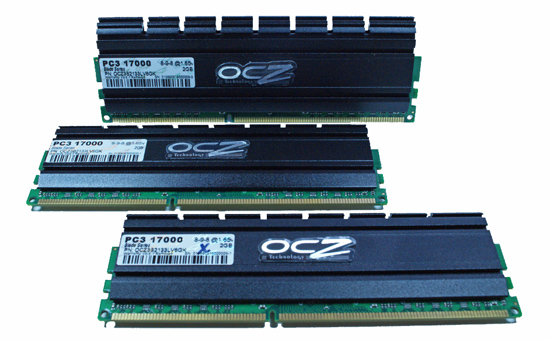
We were discussing our initial overclocking results with a couple of BIOS engineers and came away surprised. We learned they typically tune memory performance utilizing a combination of Sandra/Everest and Super Pi. That did not shock us but it explains why time after time our various test systems would perform exceptionally well in the synthetic benchmarks and then fall flat on their collective faces when faced with heavy multitasking situations. We believe too much emphasis is placed on trying to win a benchmark that in no way reflects the true performance of applications or enhances the stability of the system.
That brings us to another story. We had planned to incorporate a full overclocking section in this article but our DDR3-1866 and DDR3-2000 kits based on the Elpida DJ1108BASE, err Hyper ICs, have been experiencing technical difficulties as of late. As in, the damn things are failing faster than we can keep replacements in the labs. This is not a vendor specific problem, nor does it seem to be a voltage problem either, as we have had modules from various suppliers fail at stock VDimm or at 1.8V when trying to push through to the DDR3-2300 level. We have asked the memory suppliers a few pointed questions and are waiting for answers. In the meantime, replacements are arriving shortly. We will follow up with additional DDR3-2000 overclocking scenarios in the near future.
Memory Pricing
We remember paying over $600 for 2GB of DDR3-1600 C7 rated at 1.90V almost two years ago. About nine months ago, when Core i7 launched a DDR3-1600 C7 6GB 1.65V kit cost us $415. A DDR3-1600 C7 1.65V 6GB kit cost us $140 last week. To add insult to injury, a recently purchased DDR3-1600 C9 1.65V 6GB kit set us back $86 compared to the $195 we paid four months ago. To say things have changed in the DDR3 memory market over the past two years would be an understatement.
In today’s testing, we did our best to utilize retail kits from various manufacturers based on their stock speed and timing ratings for each of our memory settings. We felt this was a better choice than taking a DDR3-2000 kit and using it at different speeds and timings as that would not represent what the actual product for sale at these price points are capable of in our test system. Of course, we violated this principal twice but for good reason. There are not any 1066 C5 kits so we bumped the voltage slightly on the Patriot 1066 C7 kit to run at these timings. Our 1866 C7 kit became incapacitated and we switched to a 2000 C8 kit that actually cost less and performed better.

The price levels listed represent our cost from Newegg at the time of purchase. Of course, prices for 6GB kits vary widely depending on the manufacturer, rebates, specifications, and product availability so consider these prices to represent a current aggregate average. We fully realize that purchasing a DDR3-2000 CAS8 kit for $235 that is capable of running DDR3-1866 C7 at like voltages is usually a better value than a $289 1866 C7 kit. Kit prices range from $80 for the DDR3-1066 C7 kit up to the $260 DDR3-2000 C8 modules for this article.
Our lead off contestant is the Patriot DDR3-1066 C7 PSD36G1066KH 6GB kit that we utilized for both the 1066 C7 and C5 results. This memory kit only required 1.60V for CAS5 operation and comes in at the low price of $80. For those operating on a strict budget, we cannot say enough good things about this kit as it easily reached DDR3-1600 C9 on 1.65V and 1.225V VTT. Speaking of DDR3-1600 C9 kits, we are now seeing these 6GB kits below $90 and if they arrive with the right IC/PCB combination, they could potentially make a great kit for down clocking to 1333 C6, which is one of our sweet spot settings for overall performance on this platform.
We tapped Corsair for our DDR3-1333 C9 kit, SuperTalent for the DDR3-1333 C8 modules, and GEIL for our DDR3-1333 C7/C6 kits. We turned to Patriot once again for DDR3-1600 C9, OCZ for a really great DDR3-1600 C8 setup, Corsair for DDR3-1600 C7, and Mushkin for one sweet DDR3-1600 C6 package. We utilized GSkill’s DDR3-2000 C8 kit for our DDR3-1866 C7 and limited overclock results. We will be reviewing each kit utilized shortly (and others) to determine the overall best value based on clocking abilities, technical support, warranty, and cost.
Memory Designations –
One of the more confusing aspects of selecting DDR3 memory are the two common designations, which are both technically wrong. The first commonly used term describes the theoretical bandwidth, as in PC16000. This numbering system represents the peak transfer rate in MB/s of the module. The other common designation describes the effective clock speed in terms like 2000MHz. If the product description does not contain the effective clock speed and you only see a number like PC8500, then divide it by eight. Therefore, through the magic of math and marketing, PC8500 becomes 1066MHz.
Of course, this is not the actual clock speed, but rather the data rate. In other words, while PC8500 sounds extremely impressive and 1066MHz just a little less so, the actual operating frequency of the DDR3 devices is much less. There is a history on why we have these inflated numbers as it dates back to the time of RAMBUS, but that is a story for another article. We just wish that the memory suppliers would pick one designation and go with it. In the meantime, we will report our numbers today in effective data rate for simplicity state. We will refer to DDR3-1066 5-5-5-18 as simply 1066 C5 as an example.
The Test
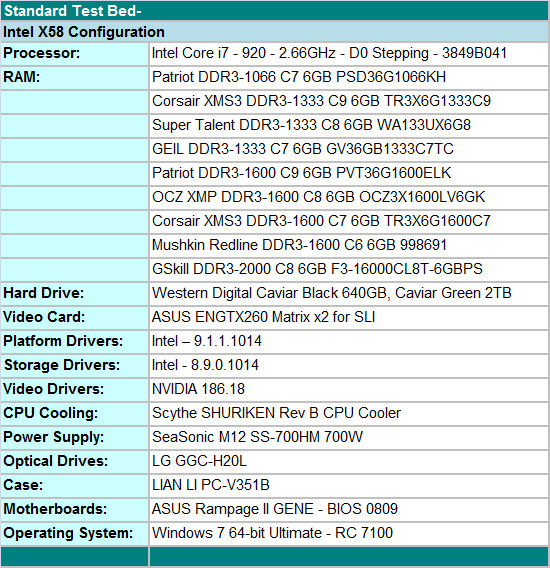
We decided to build an i7 uATX system for testing today. We certainly had our pick of various components for a memory test bed with the EVGA Classified, Gigabyte X58 Extreme, and DFI UT X58 boards coming to mind along with higher end video card and storage selections. In the end, we decided taking a practical approach to the component selection would serve us better in showing memory results on a system considered mid-range in the i7 world from a performance viewpoint. We will follow up shortly to see what differences occur in memory performance when utilizing an SSD, different memory/board timings, and additional benchmarks with Virtualization routines.
We settled on the ASUS Rampage II GENE as our motherboard choice based on the available feature set and BIOS options. You could certainly cost reduce this system and utilize the excellent MSI X58M motherboard. Our processor choice was easy as the Core i7 920 is the best selling i7 product and represents what most users currently pair with an X58 board.
We selected the ASUS ENGTX260 video card for GPU duties. It is a non-reference design that offers improved thermals and acoustics over the standard NVIDIA GTX 260 216 designs. The WD Caviar Black 640GB is our hard drive of choice for primary storage purposes with the WD Caviar Green 2TB drive as a logical choice for backup duty. LG’s GGC-H20L Blu-ray playback capable drives fills in for optical duties.
We purchased several 6GB kits for memory duties. We set the BIOS to the advertised settings for each kit on the primary timings and left the sub-timings on auto in the BIOS. Of course, those who like to play around in the BIOS could certainly improve upon our synthetic results but overall, we found very little if any differences in actual applications when tuning the sub-timings.
We chose the Scythe SHURIKEN Rev B CPU Cooler for air-cooling duties. This cooler features a low profile design with quiet operation and good cooling characteristics, which is perfect for a base SFF setup. For the more performance oriented crowd we highly suggest the Thermalright AXP-140 with a Thermaltake 140mm fan. We are currently testing this combination for a uATX shootout and it works well.
Our standard power supply is the excellent SeaSonic M12 SS700HM 700W modular unit. This power supply also works for SLI/CF testing since it supports the necessary PCIe connectors. LIN LI’s PC-V351B turned out to be an excellent choice for this setup although our loaded system was cramped for space. We had to complete some creative engineering for all the cooling systems to work properly while taming cable management obstacles. We utilized the ASUS VH242H 23.6" 1920x1080 LCD monitor for display duties. Finally, we have dropped Vista 64-bit and moved to Windows 7 Ultimate 64-bit for our testing today - it just works better.
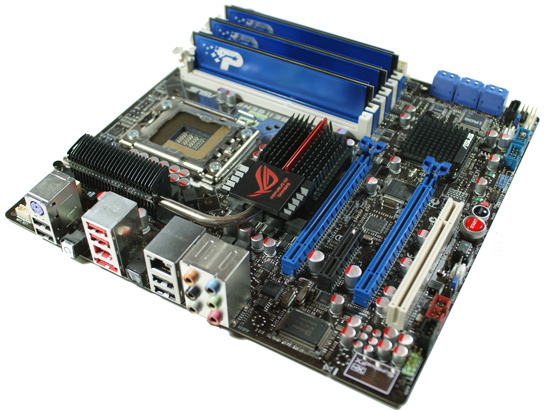
Our software choices represent a wide variety of applications and we selected 64-bit versions of the program where applicable to ensure full access to our 6GB memory configuration. Unless otherwise noted, we run each benchmark three times and average the results for our score. We clear the prefetch folder between each test run, defrag, and then reboot when switching to a new benchmark. Our programs are updated to the latest release from the supplier. Turbo mode along with HT is enabled on the Core i7 920 and power management is set to balanced for testing.
Everest 5.02.1765
Our favorite PC diagnostic tool is from Lavalys. We are using Everest Ultimate Edition 5.02 for our synthetic memory benchmarks.
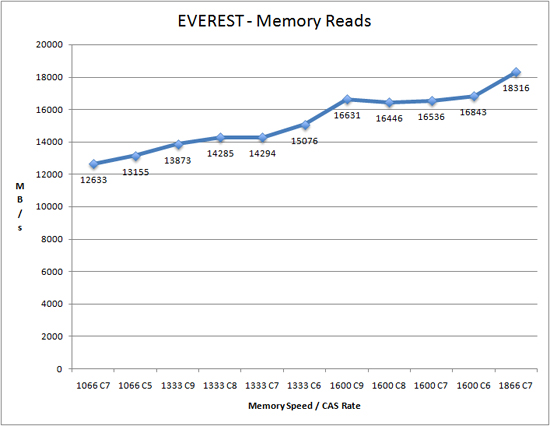
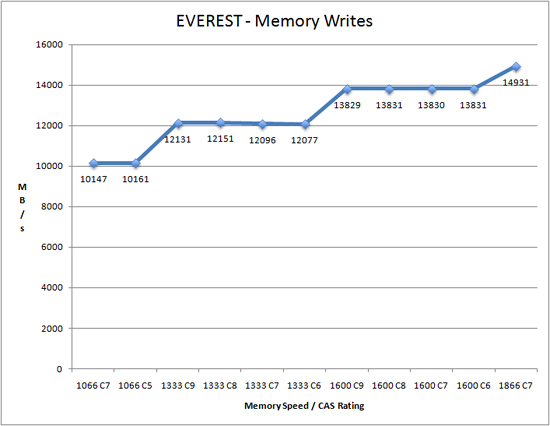
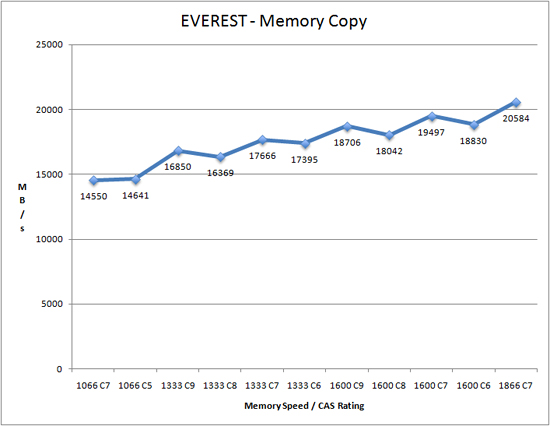
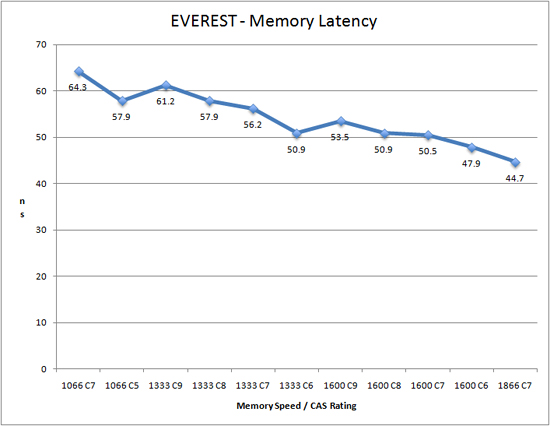
Memory companies love to see these benchmarks in reviews. Of course we enjoy them also as they do give an indication of potential performance improvements in applications, especially the write, copy, and latency results. However, we always temper our expectations with these particular results. Going from 1066 C7 to 1866 C7 nets a 45% improvement in memory reads, 47% in writes, 41% in copy speeds, and 30% in latency. Just remember these results once we get to the application benchmarks.
PCMark Vantage x64
Futuremark's PCMark Vantage x64 is probably the single most diverse set of benchmarks that can be run on a system to mimic real world usage scenarios. We utilized the three test suites out of PCMark Vantage x64 that typically respond well to either memory latency (Memories/Productivity) or bandwidth (TV/Movies) improvement. We run each test three times and average the results.
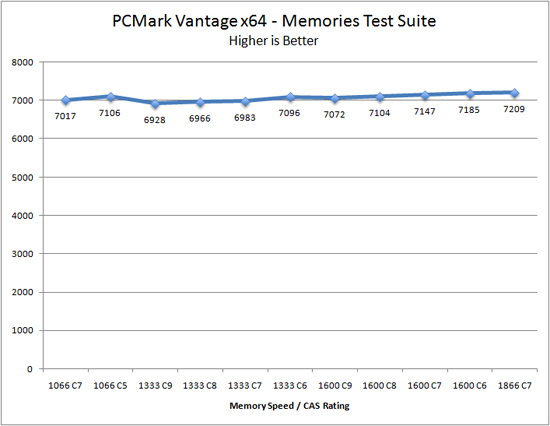
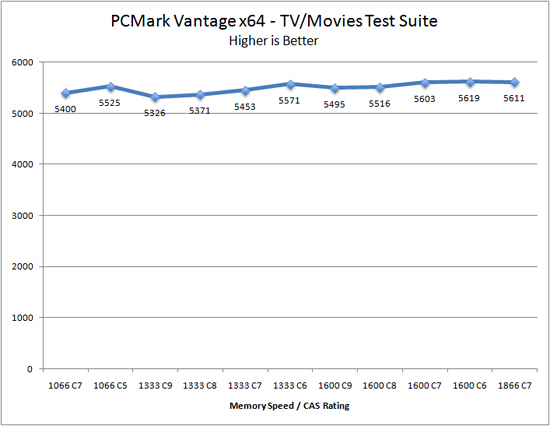
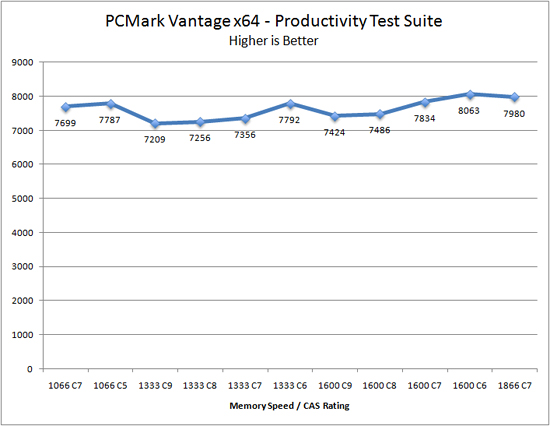
Well that's depressing, there's hardly any performance improvement.
The Memories test suite follows a familiar pattern, as it tends to be sensitive to latency adjustments. We can already see that performance with DDR3-1066 C5 is equal to DDR3-1600 C8. There is a 2% performance improvement moving from 1066 C7 to 1866 C7.
Surprisingly, the TV/Movies test suite responded well to both latency and bandwidth improvements with DDR3-1066 C5 and DDR3-1333 C6 outperforming the other memory speeds until we installed theDDR3-1600 C7 kit. Going from 1066 C7 to 1866 C7 will net almost a 4% improvement in performance, but is something most users will never notice in these applications.
The Productivity test suite has always been sensitive to latency and it shows as we once again see DDR3-1066 C5, DDR3-1333 C6, and DDR3-1600 C6 performing very well in this office application bench. We net a performance increase just over 3% by moving from 1066 C7 to 1866 C7 at stock CPU settings.
Sometimes Memory Bandwidth Makes a Difference
Thankfully, for the memory makers at least, things aren't always as bleak as the PCMark Vantage results. Out of the forty or so applications we tested (23 reported on) in compiling this article, these are the applications that displayed differences worth mentioning when either increasing memory bandwidth or decreasing latencies.
WinRAR 3.9b3 x64
This benchmark compresses our AT workload consisting of a main folder that contains 954MB of files in 15 subfolders. The result is a file approximately 829MB in size.
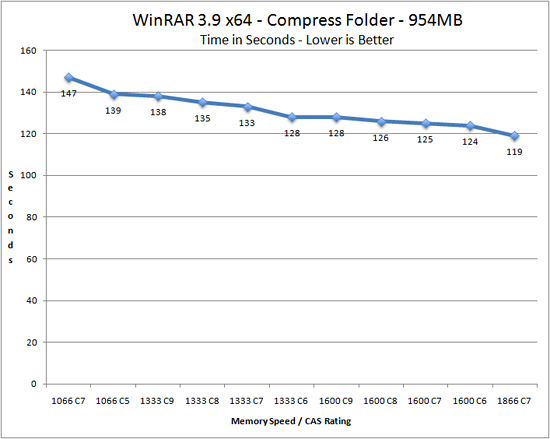
WinRAR loves bandwidth and latency improvements. Of all the applications we tested, this one responded best to improved memory performance. Going from DDR3-1066 C7 to DDR3-1866 C7 resulted in a 20% decrease in processing time by just varying memory speeds. Latency improvements within a given memory speed were most noticeable with 1066 C5 being about 6% quicker than 1066 C7 and 1333 C6 around 8% faster than 1333 C9.
Cinema 4D R11 x64
Cinema 4D R11 is one of our favorite programs to create high-end 3D images and animations. We track the time it takes to render a swimming pool layout.
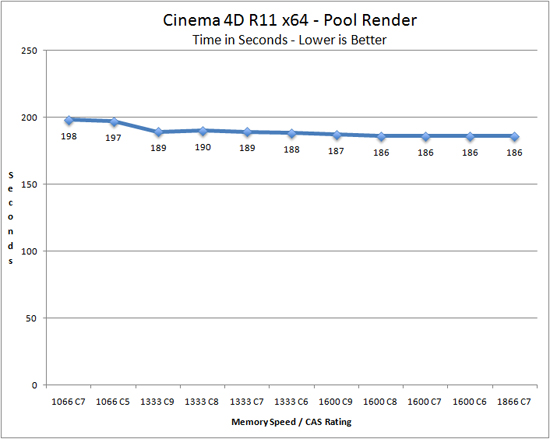
Maxon’s top flight program is bottlenecked at DDR3-1066 speeds and responded well to improved memory bandwidth with a 7% performance increase going from 1066 C7 to 1866 C7.
LightWave 3D 9.6 x64
Another popular 3D rendering program is Lightwave 3D 9.6. In this test we time the rendering of a single frame from an office building animation. The time to render the full scene is approximately four and a half hours.
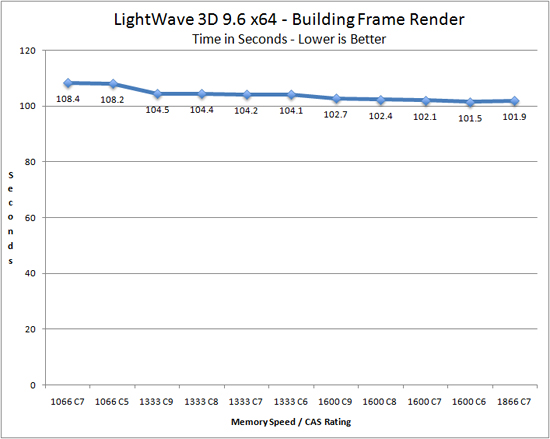
Newtek’s premier application responded well to improved memory bandwidth with a 6% advantage for DDR3-1866 C7 over DDR3-1066 C7.
Tom Clancy's H.A.W.X.
While not a true flight simulation or even serious air combat game, it is a lot of fun and looks visually stunning on a 30” monitor with all options turned up. In our case, we set all options to high, enable 2xAA and DX10, and then use FRAPS to time a custom demo sequence. We run three loops of the benchmark and average our scores for the results.
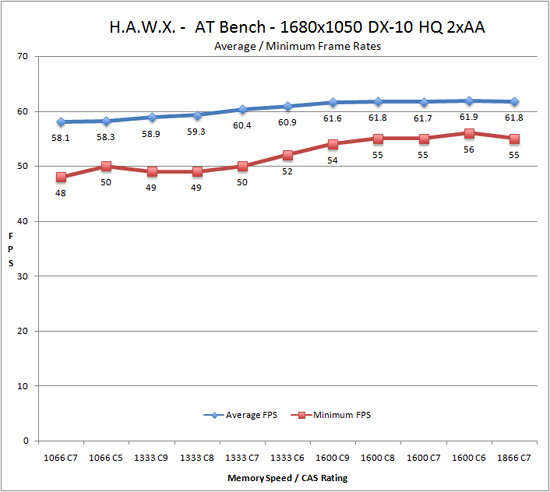
We noticed in several games that decreased latencies and/or increased bandwidth tended to improve minimum frame rates more so than average frame rates. In the case of H.A.W.X., minimum frame rates improved about 14% going from 1066 C7 to 1866 C7, while average frame rates improved 6%.
Heavy Multitasking: The Other Safe Haven for Faster Memory
The vast majority of our benchmarks are single task events that utilize anywhere from 23MB up to 1.4GB of memory space during the course of the benchmark. Obviously, this is not enough to fully stress test our 6GB memory configuration. We devised a benchmark that would simulate a typical home workstation and consume as much of the 6GB as possible without crashing the machine.
We start by opening two instances of Internet Explorer 8.0 each with six tabs opened to flash intensive websites followed by Adobe Reader 9.1 with a rather large PDF document open, and iTunes 8 with The Who blaring loudly. We then open two instances of Lightwave 3D 9.6 with our standard animation, Cinema 4D R11 with the benchmark scene, Microsoft Excel and Word 2007 with large documents, and finally Photoshop CS4 with our test image.
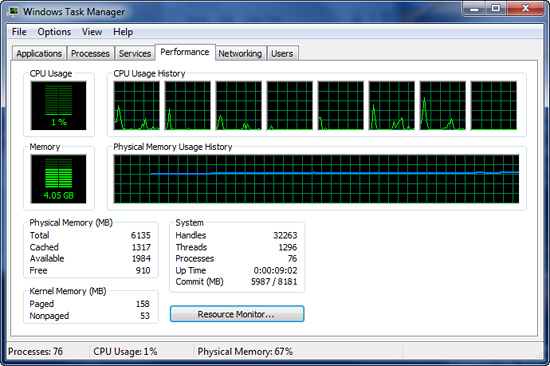
Before we start the benchmark process, our idle state memory usage is 4.05GB. Sa-weet!
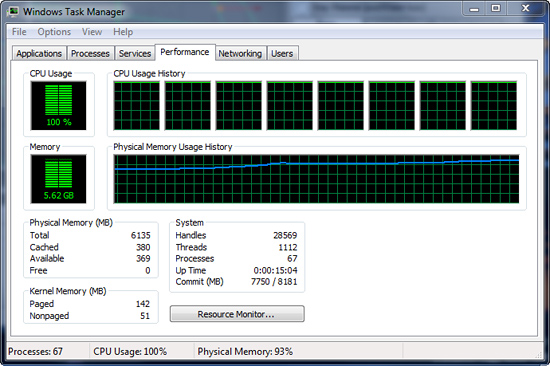
We wait two minutes for disk activity to cease and then start playing Pinball Wizard via iTunes, start the render scene process in Cinema 4D R11, start a resize of our Photoshop image, and finally the render frame benchmark in Lightwave 3D. Our maximum memory usage during the benchmark is 5.62GB with 100% CPU utilization across all eight threads.
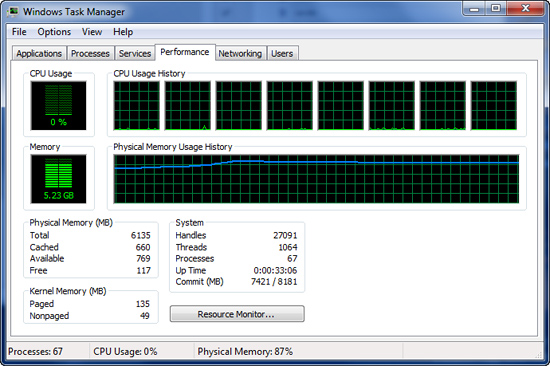
Our idle memory footprint after the benchmark has completed is 5.23GB. Trying to run our normal Photoshop benchmark at this point resulted in an out of memory error and automatic shutdown of Photoshop CS4 x64.
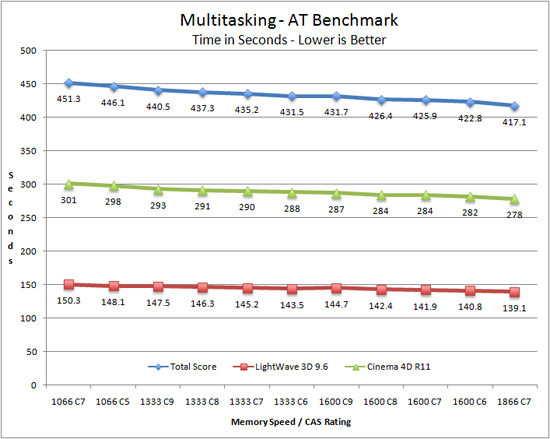
Our results follow an almost linear scale as we increase memory bandwidth in this benchmark. Improved latencies only matter when combined with increased memory bandwidth for the most part except for the DDR3-1333 C6 results just edging past the DDR3-1600 C9 score.
There is an 8% improvement in the total benchmark score when moving from DDR3-1066 C7 to DDR3-1866 C7. If you multitask with several memory intensive applications, at stock CPU speeds, increasing memory bandwidth is a simple way to improve performance.
Overclocked
Based on the above results at stock CPU speeds, we decided it would be interesting to look at what occurs when we overclock the system. We arrived at a 3.8GHz processor clock speed via the 19x200 setting. Essentially this is a free overclock as our CPU only needed an increase in VTT to 1.35V (board/processor dependent) to handle the increased memory loads at DDR3-1600 C6 and DDR3-2000 C8.
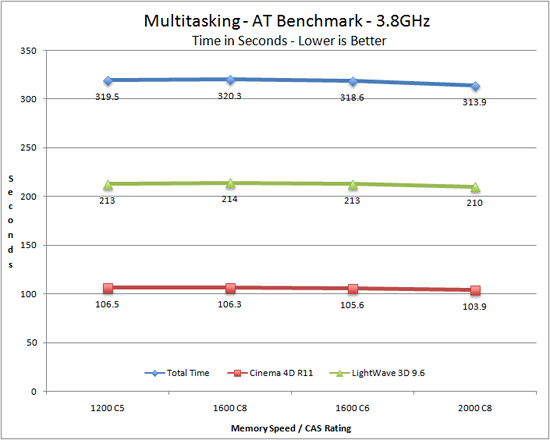
It is not until we hit DDR3-2000 C8 that our system responds favorably to increased memory bandwidth. Even then, the improvement is not as drastic as our stock numbers as going from DDR3-1200 C5 to DDR3-2000 C8 only improves performance by 2%.
The Rest of the Story: Applications that Don't Care About Memory Performance
Not everything is as impressive as the past two pages of results, the following applications show little or no performance improvement regardless of memory speed or timings.
Sorenson Squeeze 5.01
We are using Sorenson Squeeze to convert eight AVCHD videos into HD Flash videos for use on websites.
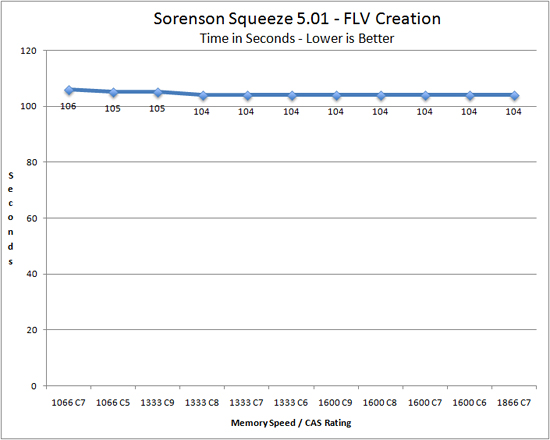
Performance levels off once we hit DDR3-1333 C8 with a 2% improvement compared to 1066 C7.
MainConcept Reference 1.61
One of our favorite video transcoding utilities is MainConcept Reference. We set our profile to iPOD HQ NTSC and then transcode a 651MB 1080P file to a iPOD friendly 34.7MB file.
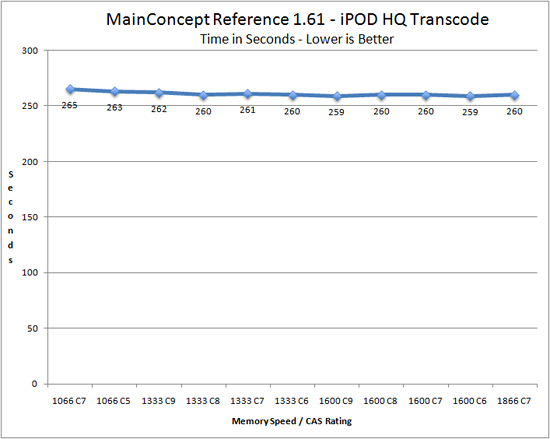
Improvements in memory bandwidth resulted in an almost 3% increase in performance when moving from 1066 C7 to 1600 C6.
Sony Vegas Pro 9.0 x64
We transcode a 370MB 1080AVCHD file using the Mainconcept MPEG-2 1920x1080 60i, 25Mbps setting with 6-channel audio.
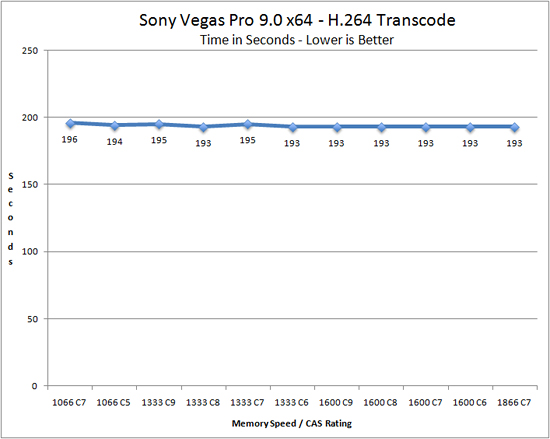
There is a 2% improvement in moving from DDR3-1066 to DDR3-1866 in this application.
CyberLink PowerDirector v7
We transcode a 651MB 1080P file utilizing the 720x480 MPEG-4 AVCHD 6-channel audio setting while performing a Light Ray effect on the output file.
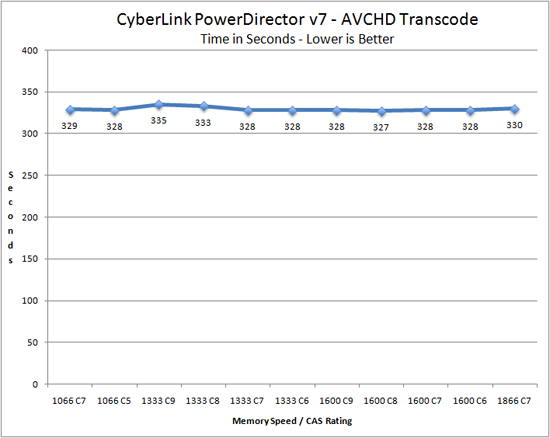
Except for the 1333 C9/C8 results, performance remains flat from 1066 C7 to 1866 C7 as your choice of memory speed is not going to really affect this particular application.
Microsoft Excel 2007 SP1
Excel can be a very powerful mathematical tool. In this benchmark, we are running a large Monte Carlo simulation on stock pricing data to estimate the riskiness of an investment portfolio.
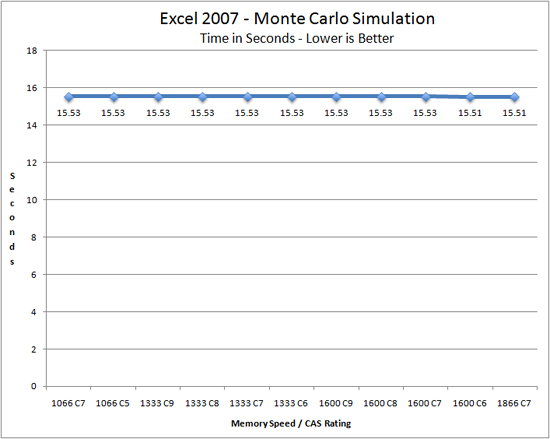
This benchmark runs entirely in cache, so the results are predictable. Memory bandwidth or latency is not going to make a real difference here.
Photoshop CS4 x64
To measure performance under Photoshop CS4 x64, we turn to the Retouch Artists’ Speed Test macro only with a custom image sized at 4800x3600. The test performs basic photo editing; a few color space conversions, several layer creations, color curve adjustment, 3x image and canvas size adjustments, unsharp mask, and finally a gaussian blur performed on the entire image.
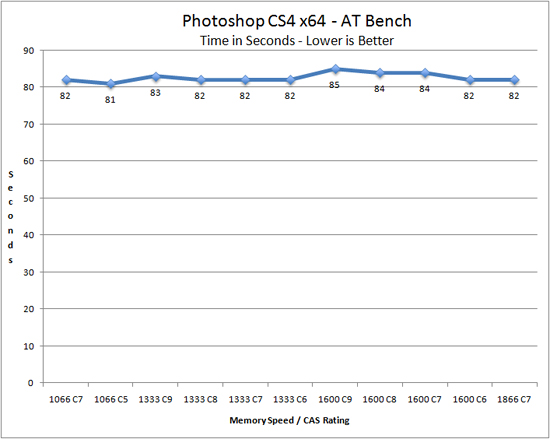
We expected different results in this particular benchmark, but it is one of several applications that responded well to DDR3-1066 C5 settings in single task mode.
Bibble 5.0
We utilize Bibble Labs’ Bibble 5 v2 to convert 50 RAW image files into full size JPEG images with the program’s default settings. This program is fully multithreaded and multi-core aware.
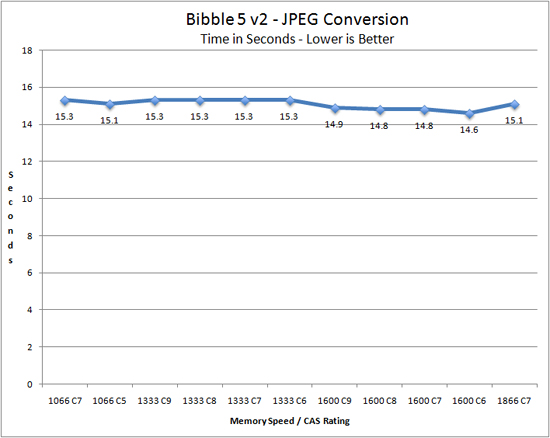
This application responds well to memory bandwidth coupled with improved latencies as we see about a 5% improvement switching from 1066 C7 to 1600 C6.
iTunes 8 x64
We import the album Tommy by The Who to our disk in WAV format. The directory consists of 25 songs totaling 751MB. We then convert this music collection to MP3 format utilizing 320Kbps VBR Highest audio settings or to an AAC format using the iTune Plus option.
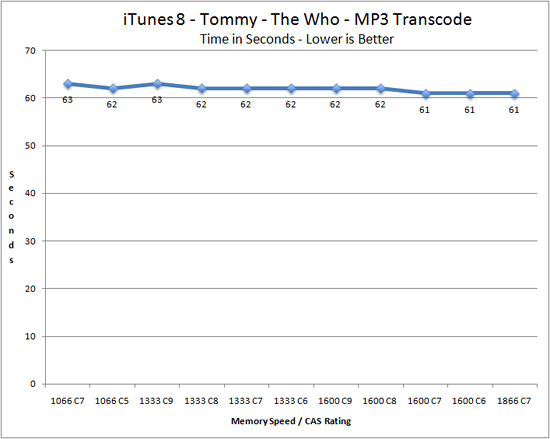
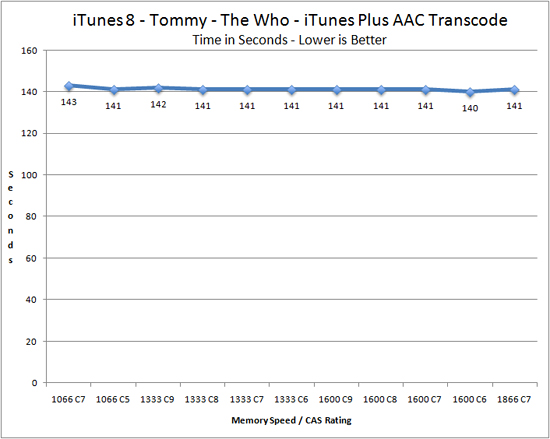
Utilizing either transcoding method, iTunes performance remains almost flat regardless of memory type. We notice about a 2% improvement switching from 1066 C7 to 1600 C6.
Gaming Performance vs. Memory Speed
One game actually made it to our list of applications that benefit from faster memory: H.A.W.X. The rest were a mix of slight to borderline noticeable increases in overall performance.
FarCry 2
Featuring fantastic visuals courtesy of the Dunia Engine, this game also features one of the most impressive benchmark tools we have seen in a PC game. We set the performance feature set to Very High, graphics to High, and enable DX10 with AA set to 2x. The in-game benchmark tool is utilized with the Ranch Small level and we report an average of three test runs.
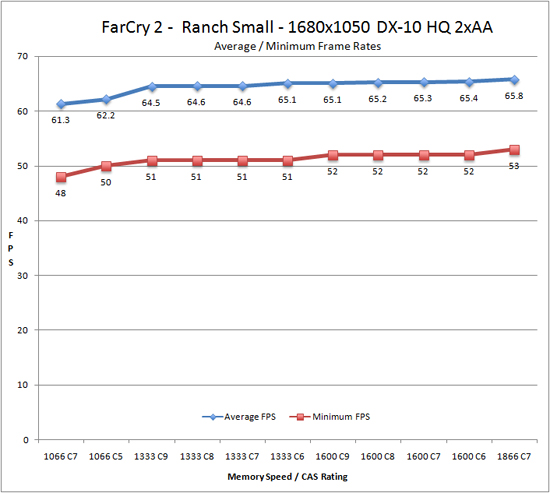
Although the differences are minor, we do notice a linear scaling in frame rates as we improve both bandwidth and latencies. Average frame rates are up 7% and minimum frame rates by 10% when moving from 1066 C7 to 1866 C7.
Left 4 Dead
This game is a blast and addictive to boot - provided you like killing hundreds of zombies while trying to take care of your teammates and sustaining high blood pressure rates. We enable all options, set AA to 2x and AF to 8x, and play back a custom demo of a game session from the Runway Finale chapter within the Dead Air campaign.
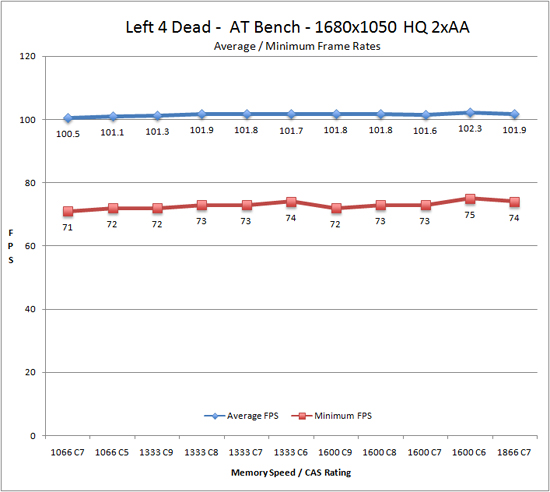
Average frame rates improved around 2% and minimum frame rates about 5% as we moved from DDR3-1066 C7 to DDR3-1600 C6. In a recurring theme, DDR3-1600 C6 offers the best overall performance although we noted no differences in game play.
Company of Heroes: Tales of Valor
The oldest title in our test suite is still the most played. CoH has aged like fine wine and we still find it to be one of the best RTS games on the market. We crank all the options up to their highest settings, enable AA at 2x, and run the game under DX9. We track a custom replay of Able Company’s assault at Omaha Beach with FRAPS.
Average frame rates improved around 4% as memory bandwidth increased with DDR3-1600 C6 offering the best overall performance. However, there was no difference in game play between 1066 C7 to 1866 C7 as minimum frame rates did not change for the most part.
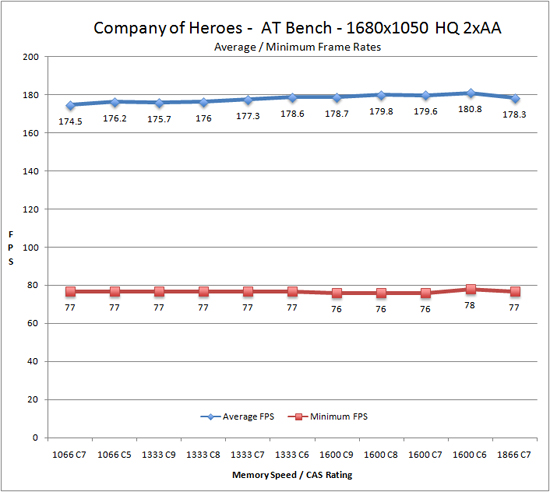
Warhammer 40K: Dawn of War II
We are big fans of the Warhammer franchise, especially Dawn of War II. One of the latest RTS games in our library is also one of the more demanding titles on both the CPU and GPU. We crank all options to High, enable AA, and then run the built-in performance benchmark for our result.
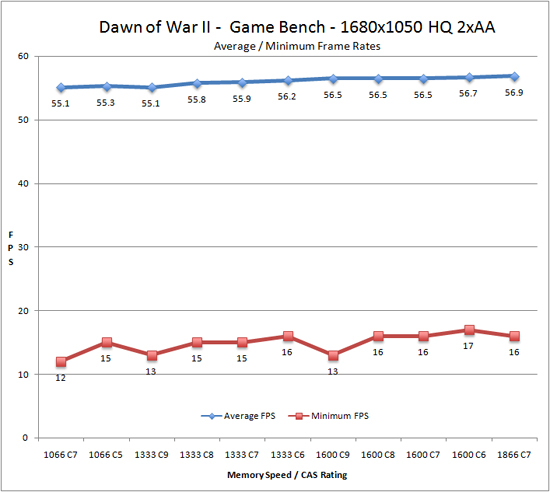
Minimum frame rates responded well to latency and bandwidth improvements with DDR3-1600 C6 offering the best overall performance. Average frame rate performance increased by 3% and minimum frame rates by 41% when moving from 1066 C7 to 1600 C6.
Tom Clancy's H.A.W.X.
While not a true flight simulation or even serious air combat game, it is a lot of fun and looks visually stunning on a 30” monitor with all options turned up. In our case, we set all options to high, enable 2xAA and DX10, and then use FRAPS to time a custom demo sequence. We run three loops of the benchmark and average our scores for the results.

In H.A.W.X., minimum frame rates improved about 14% going from 1066 C7 to 1866 C7, while average frame rates improved 6%.
World in Conflict - Soviet Assault
WIC is an RTS favorite around here and one that can still bring the latest systems to their knees if all options are enabled. We set our options to High, DX10, 2xAA. 4xAF, and then utilize FRAPS to track a repeatable game sequence for our results.
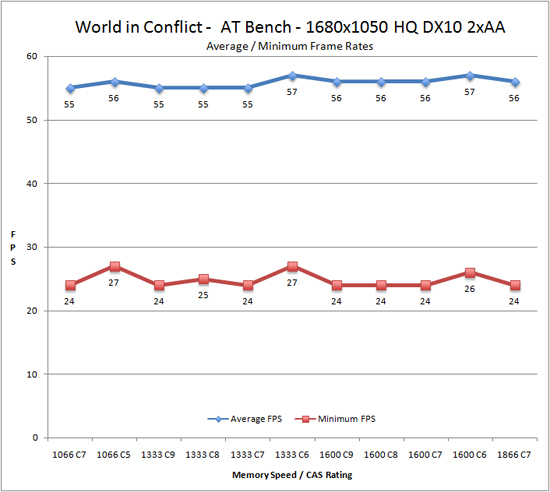
Another example of the ping pong effect as memory bandwidth and latencies are optimized at 1066 C5, 1333 C6, and 1600 C6 settings, which offer the best overall performance. DDR3-1333 C6 offers a 3% improvement in average frame rates and 12% in minimum frame rates over 1066 C7 as one example.
Even though our DDR3-2000 kits were not cooperating with us, we were able to run a few benchmarks to determine which memory setting would be ideal at our 3.8GHz (19x200) processor speed. We arrived at this clock speed, as it is a free overclock with only VTT needing to be increased to handle our particular memory speeds and timings. We will take a look at other overclocked speeds and memory settings in the near future.
Everest 5.02.1765
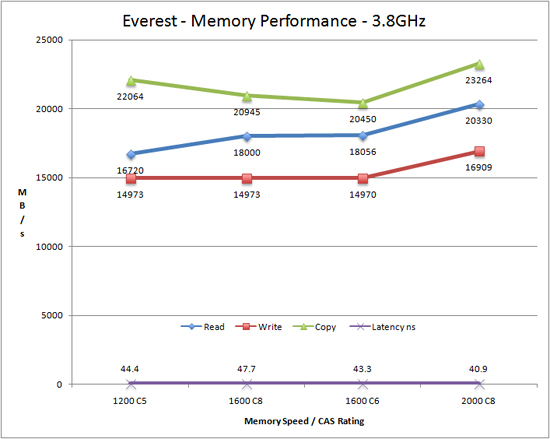
Going from 1250 C5 to 2000 C8 nets a 5% improvement in memory reads, 21% in writes, 13% in copy speeds, and 8% in latency. Interestingly enough, 1200 C5 provides excellent results compared to 1600 C8 and our application benchmarks reflect this fact.
AutoCAD 2009 x64
We utilize AutoCAD 2009 x64 and the Cadalyst Labs benchmark.
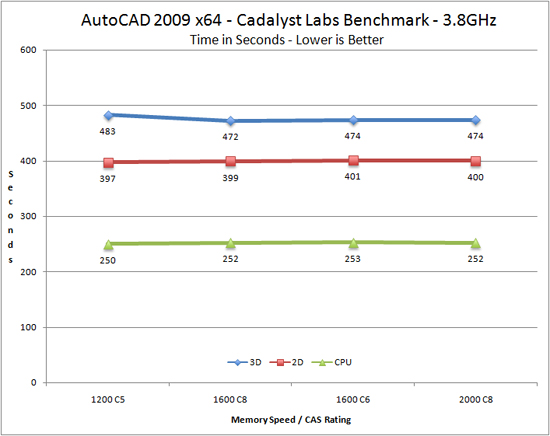
Just like our stock clock results, the 3D scores are respond better to the slower memory speeds. Once again, decreased latencies and greater bandwidth generally resulted in improved 2D and CPU scores.
3ds Max 2009 x64
We utilize a rather large mental ray image and track the time it takes to render it.
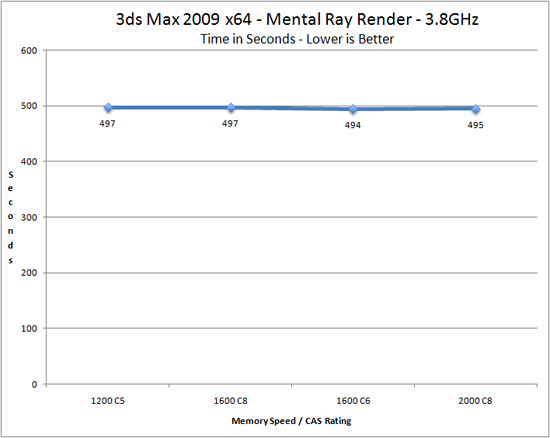
In our stock test we measured a 3% increase in performance (19 second reduction) moving from DDR3-1066 C7 to DDR3-1600 C6. In our overclock test the 2 second difference between 1200 C5 and 2000 C7 is minimal as clock speed is king at this point.
LightWave 3D 9.6 x64
We time the rendering of a single frame from an office building animation. The time to render the full scene is approximately four and a half hours.
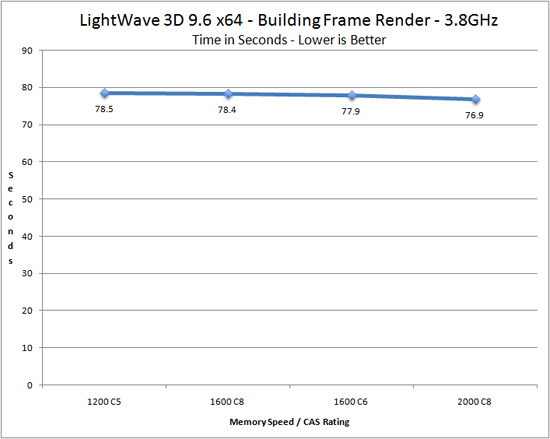
The stock test revealed a 6% advantage for DDR3-1866 C7 over DDR3-1066 C7. The overclock test indicates a 2% advantage for 2000 C8 compared to 1200 C5.
WinRAR 3.9b3 x64
This benchmark compresses our AT workload consisting of a main folder that contains 954MB of files in 15 subfolders. The result is a compressed file approximately 829MB in size.
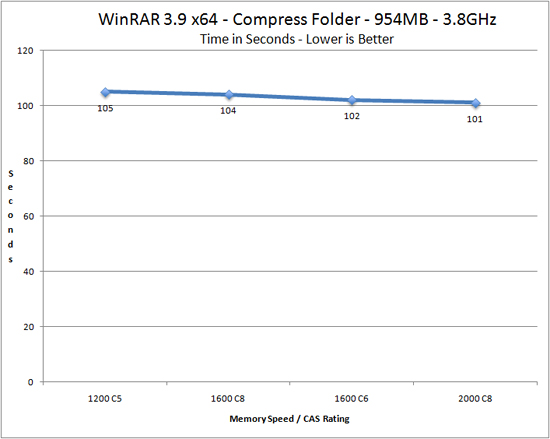
In our stock tests, going from DDR3-1066 C7 to DDR3-1866 C7 resulted in a 20% decrease in processing time. With our processor overclocked to 3.8GHz, this benchmark provides a 4% increase in performance when moving from 1200 C5 to 2000 C8.
MainConcept Reference 1.61
We set our profile to iPOD HQ NTSC and then transcode a 651MB 1080P file to a iPOD friendly 34.7MB file.
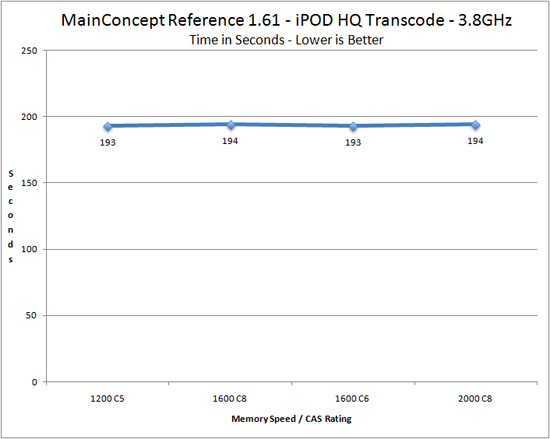
Our stock test showed a 3% improvement in performance when scaling from DDR3-1066 to DDR3-1866. Overclocking our system resulted in a .05% variation in the score with our two low latency settings performing ever so slightly better.
Game Performance – Overclocked with SLI
Once again, we overclock our Core i7 920 to 3.8GHz (19x200) and run our standard game benchmarks at 1680x1050 2xAA HQ settings in single card and SLI configurations. This is a short synopsis of the results, but our other game benchmarks along with a 1920x1080 resolution performed in a similar manner. It appears in most of our games that minimum frame rates and sometimes average frame rates responded to the latency advantages inherent in 1200 C5 operation compared to the pure bandwidth advantage in 2000 C8.
FarCry 2
We set the performance feature set to Very High, graphics to High, and enable DX10 with AA set to 2x. The in-game benchmark tool is utilized with the Ranch Small level being selected for demo duties.
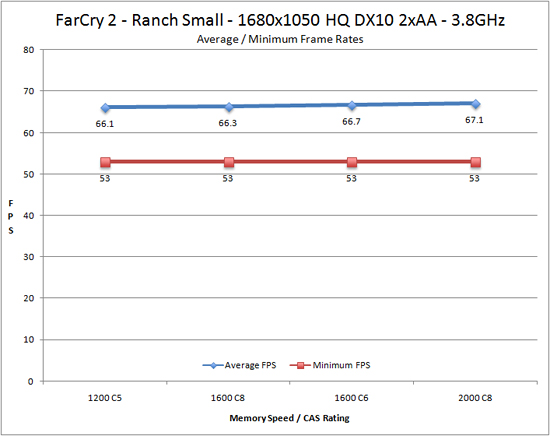
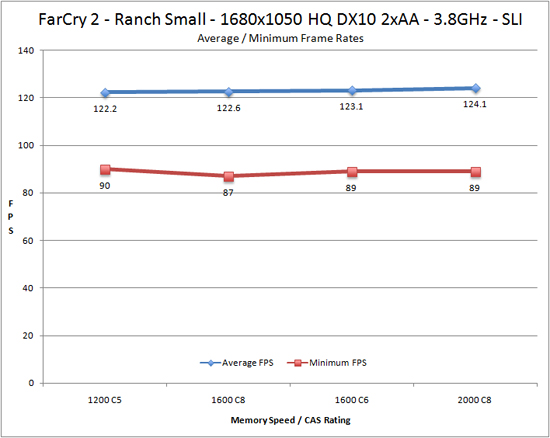
Average frame rates are up an astounding (had to make it interesting) 1% utilizing 1200 C5 over 2000 C8 while minimum frame rates improve by a ground shattering 0% when moving from 1200 C5 to 2000 C8 in single card results. In SLI operation, average frame rates improve by a familiar 1% as we crank up memory speed while minimum frame rates are 1% better when using 1200 C5 compared to 2000 C8. Obviously, the impact on actual game performance was nonexistent with any of our memory choices.
Warhammer 40K: Dawn of War II
We crank all options to High, enable AA, and then run the built-in performance benchmark for our result.
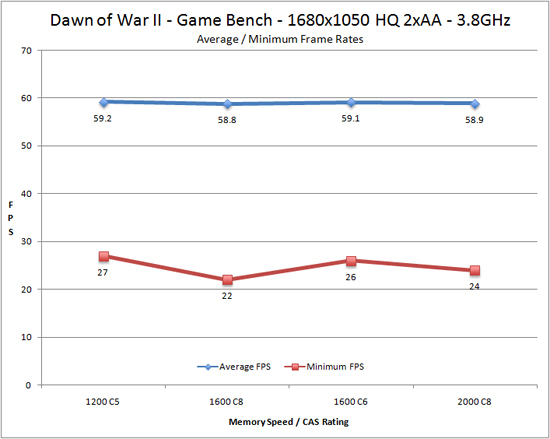
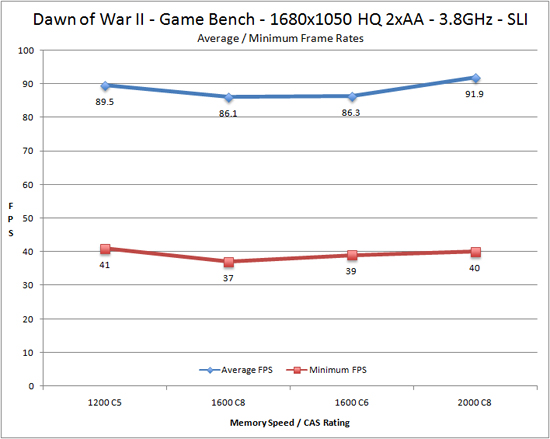
In our stock tests, this game responded very well to memory changes as average frame rate performance increased by 3% and minimum frame rates by 41% when moving from 1066 C7 to 1600 C6. However, in single card mode we see a minimal impact on average frame rates while minimum frame rates improve by 12% using 1200 C5 compared to 2000 C8. In SLI mode, average frame rates increased almost 3% moving from 1200 C5 to 2000 C8 but minimum frame rates improved a little over 2% with 1200 C5 having the advantage over 2000 C8.
World in Conflict - Soviet Assault
We set our options to High, DX10, 2xAA. 4xAF, and then utilize FRAPS to track a repeatable game sequence for our results.
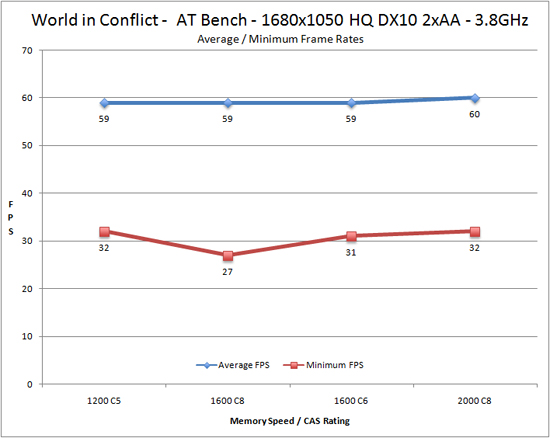
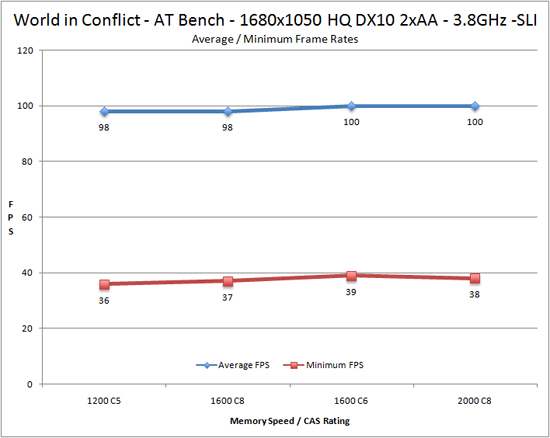
Our single card results have the average frame rates flat lining but we do see a drop in minimum frame rates with DDR3-1600 C8. In the SLI test, average frame rates improve by 2% and minimum frame rates by 5% when moving from 1200 C5 to 1600 C6.
We raised the question at the beginning of this article: is there any value in using memory faster than DDR3-1066 on the Core i7 platform? In certain situations that answer is a definite yes and in others we really doubt the actual value of using anything more than a good triple channel DDR3-1066 6GB kit running at tight latencies, at least CAS 7 and preferably CAS 5.
What we discovered is that faster memory certainly makes a splash in our synthetic Everest benchmarks with memory read, write, and copy speeds showing improvement in the 40% range when moving from DDR3-1066 C7 to DDR3-1866 C7. Latency improvements improved by 30% in the same tests. However, we expected this, and for that reason we did not run the standard Super Pi or early 3DMark tests that heavily depend on memory and cache speeds for best results.
Once again, as we moved to real-world applications, those impressive synthetic benchmark improvements did not translate into results that would justify spending three times as much for a memory kit for most people. We had mixed with certain applications like WinRAR producing a 20% improvement from DDR3-1066 C7 to DDR3-1866 C7 while several applications showed minor performance improvements under 2%. If your primary job is to compress and archive files for a living, then the expenditure for fast low latency memory is justifiable. However, the decision to spend additional funds on higher performance memory is quickly up in the air after this point.
In our 3D rendering tests like Cinema 4D R11 and LightWave 3D 9.6, which we know to be sensitive to memory speed, additional memory bandwidth can provide tangible performance improvements of up to 7% or greater. Certainly, our multitasking benchmark showed the benefit of both greater memory and reduced latencies with performance improving 8% as we heavily loaded the system with multiple tasks and a large memory footprint. For users in this category, we have to agree that improving memory bandwidth will be beneficial.
However, common desktop applications such as Excel, Photoshop CS4, iTunes, and others just do not benefit that much from improved memory bandwidth or latencies. That brings us to games. Average frame rate improvements improved up to 7% by increasing bandwidth and reducing latencies but we never noticed the difference when actually playing the game. However, we noticed minimum frame rates improving up to 14% as we increased bandwidth and reduced latencies. This is an important fact as minimum frame rates are a better indicator of performance than averages in most cases. In our particular benches, the improved minimum frame rates took Dawn of War II from being a stutter fest in heavy action sequences to relatively smooth when moving from 1066 C7 to 1333/1600 C6.
Once we overclocked our system, the playing field equalized for the part as latency improvements had just as much impact on performance, if not more so at times, than bandwidth in most of our applications. In fact, in our multitasking test that showed an improvement of 8% at stock speeds, the difference between 1200 C5 to 2000 C8 was only 2%. Even our top responding application, WinRAR, managed just a 4% performance increase when moving from 1200 C5 to 2000 C8 compared to the 20% increase when moving from 1066 to 1866 in the stock test. The increase in CPU speed outweighed any potential gains in memory bandwidth or latency improvements in our benchmarks.
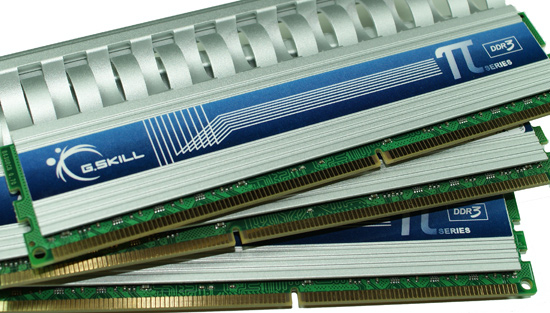
Based on today’s overall results, we have to question the validity or purchasing high-end memory for most users. Whether we like to admit it or not, most of us home users tend to be single task users when it comes to running an important application or game. Sure, we might have a few IM programs open, several browser windows, email, an occasional video or audio application, maybe Word, and then we have a major application like Photoshop or a game open. Although most gamers I know will close just about everything down to get the best video performance, several still run many applications in the background while gaming.
We might consider this multitasking but in reality, we have many programs sitting in the background while concentrating on a single task like Photoshop or Premier Pro as an example. We typically are not encoding last week’s party video in MainConcept Reference, have Cinema 4D R11 and LightWave 3D 9.6 rendering our latest artistic creations, and Photoshop is making us look a lot better in a swimsuit than we ever could while watching the latest BD title with Grandma singing Boom Boom Pow on Skype Video.
Of course, those that are doing all of these activities and more will benefit from purchasing fast low-latency memory and we even suggest getting 12GB while you are at it. For the rest of us, the primary applications we run and whether or not we overclock will have a large say in what is best for us. There is also the budget to consider, as most of us actually have to adhere to one. Looking at it from a budget viewpoint, is it worth paying 225% more for a DDR3-2000 C8 6GB kit over a DDR3-1066 C7 kit for an average performance improvement of 5% across a wide range of today’s most popular applications?
For a significant portion of users who run at stock or near stock speeds with system stability being paramount, we think not. For these users we suggest a DDR3-1066 C7 kit like the one we used from Patriot that has the capability of performing at 1066 C5 with a small bump in voltage and that can reach DDR3-1600 C9 (an excellent comprise setting due to pricing changes this past week) at warranty and system friendly voltages. This allows some growth potential in the system or the ability to increase bandwidth in the future at relativity low cost. Another excellent option in this price range is the GEIL DDR3-1333 C7 6GB kit we used that had no problems running at 1333 C6 or 1600 C8 with a small yet warranty friendly bump in VDimm and VTT. In fact, this particular kit or ones like it hit the performance sweet spot for users wanting very good performance with an eye to future overclocking efforts.
We know there is another section of users, enthusiasts to be exact, who balance their needs between stability but also extracting as much performance out of their systems on air or water cooling who need something more than DDR3-1066, even at CAS5. For these users we highly suggest going with a DDR3-1333 C6 6GB product or one that will do C6 with minimal voltage increases as a base choice. Based on recent price adjustments, a good budget to performance compromise would be DDR3-1600 C9. However, in individual module testing our 1333 C7/C6 kits had more clocking headroom along with the ability to run lower timings than our 1600 C9 sample. For those who tend to overclock 24/7 while running a multitude of applications, a DDR3-1600 C6 6GB capable kit is our best suggestion without going into debt on the DDR3-2000 kits.
We tend to favor running low-latencies at any given memory speed to ensure the best possible performance and as such we tend to stray from any of the CAS8 or CAS9 kits below DDR3-1866, unless they are capable of running much lower timings on like voltages. As such, we think DDR3-1600 C6 offers the best overall application performance in the market today for the enthusiast if you are willing to pay for it. That could be for a C6 certified kit similar to the ones we used from Mushkin or several of our DDR3-1600 C7 or DDR3-1866/2000 C8 kits had no problems running 1600 C6 with proper VDimm and VTT settings. In the near future, we will review all of the kits utilized today to determine the best value in each category, but for now, consider our choices to be safe ones.
Of course, for the extreme users dedicated to benchmarking, you can toss out all of our recommendations and just go for the DDR3-2000 C7 or better kits. In the end, there is no denying that the Core i7 processor will always perform better when paired high bandwidth low-latency memory. Just how much better depends on the application or situation, but Intel was certainly in the ballpark when they designed this platform around low-latency triple channel DDR3-1066.
You really do not give up that much performance with DDR3-1066 when compared to the more expensive alternatives and that is a good thing to know when putting a system together on a budget. As such, there is still great value in using it. If you have budget freedom, first off I am sure you will be a memory company’s best friend. Secondarily, temper your desires to go straight for the DDR3-2000 kits. It should be a comforting thought that purchasing a DD3-1333 C6 or DDR3-1600 C6 capable kit will offer the balanced performance you are seeking at price that should still allow a night out on the town this month.













